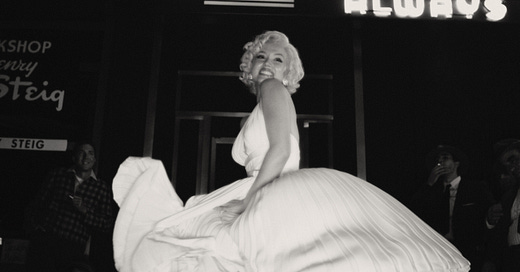A Star Is Not Born
In the new Marilyn Monroe biopic ‘Blonde,’ the disturbed depiction of motherhood as the end-all, be-all of Norma Jean’s ambitions reduces the actor to her womb and a caricature of hysteria.
Blonde director Andrew Dominik seems more concerned with warping Marilyn Monroe’s life into a grotesque morality tale than handling its more complicated truths. The film, based on Joyce Carol Oates’s fictionalized biography of Marilyn Monroe née Norma Jean Baker, is an incoherent tour of abuses and humiliations Norma Jean (Ana de Armas) is subjected to starting in childhood, skipping her adolescence, and resuming with her early and foreshortened adulthood.
Monroe was victimized by nearly every figure in her life—man and woman alike. The film focuses on her relationships with men, punctuated by the occasional visit to her mother (Julianne Nicholson) in an insane asylum. After a fabricated threeway with Charlie Chaplin Jr. (Xavier Samuel) and Edward G. Robinson Jr. (Evan Williams) that is given such a disproportionate amount of screentime that it felt like a filler episode in a late-season television drama, two of her husbands, Joe DiMaggio (Bobby Cannavale) and Arthur Miller (Adrien Brody), take their turns at abuse and exploitation. Other men on the dance card of misery Dominik sets out for Norma Jean include studio executive Mr. Z (David Warshofsky), who rapes her, and President John F. Kennedy (Caspar Phillipson), on whom she performs fellatio while providing voiceover for the act.
While her character is sent careening through scene after scene of brutal subjugation, Ana de Armas does what she can with what she’s given. Audiences get a limited glimpse of Marilyn Monroe’s talents as an actress. Her ambition is framed as a desire to recover the parental love she never received and to be a mother herself. As the persona of Marilyn Monroe gains her mythic status, Norma Jean begins a refrain of “she isn’t me.” But Dominik does little to differentiate them.
The film’s shooting style is hectic and uneven—Dominik employs competing qualities and techniques. There is no overarching thematic consistency of style, jumping back and forth from noir black and white to color, high contrast to standard color grading. Then there are the groan-worthy transitions: glittering stars to swimming sperm, lovers’ bed to waterfall, rockets to erections, etc. It is chaos. There is the sense that the whole project could be, wants to be, camp—if camp were simply about bad taste.
As for its literary origin, it seems more like Dominik read Ian McEwan’s novel Nutshell and took it as a challenge to come up with something worse. Ana de Armas may be the lead, and her performance is the only saving grace in the movie, but the real star of the show is a CGI fetus. Again and again, viewers are subjected to a glowing pink and orange sentient floating embryo that is aborted (twice) and miscarried and even speaks to Norma Jean directly demanding to know why she “killed her baby.” If this were not enough, the abortion scenes include a point of view shot from inside the vagina as forceps force open the birth canal.
The use of the CGI fetus—which we see go from early germinal embryo to fully-formed late-stage fetus—is shocking in its absurdity. The abortions forced on Norma Jean are early stage and viewers never see her with a bump, so the use of the near-term fetus is farcical.
Emphasizing the cruelties inflicted on Norma Jean and using fright-style filming techniques popularized by Hitchcock and John Cassavetes: This is not a biopic, it is a horror film that relishes in a woman’s suffering. As Angela Frank wrote for the Daily Beast, “Rosemary’s baby has nothing on Marilyn’s.”
The only moment approaching genuine poignancy that might break up the onslaught of ham-fisted visual gags—which range from obvious, tacky, and indelicate to downright vulgar and invasive—is when her makeup artist, Whitey, says over and over “She’s almost here” as he reapplies blush to a drugged and sobbing Norma Jean in an effort to summon forth her famed alter ego. The scene suggests that even though she failed at becoming a mother she could in some way be redeemed by her beauty and ability to inhabit this other persona for public consumption even if it had to consume her first.
Under normal circumstances there is something unsettling about a movie that goes to great lengths chronicling harm inflicted both bodily and psychologically on a once-in-a-lifetime movie star, but it is especially so with Brad Pitt as a producer following revelations that Angelina Jolie was the plaintiff in an FBI lawsuit alleging abuse from her then-husband.
So much of the film is gratuitous in its callousness. Somewhere in those 2 hours and 46 minutes, if only someone, anyone, in the production company had had the courage or nerve to insist on editing it down, there is a decent 90-minute picture fictionalizing what trauma, grief, and fame did to Norma Jean Baker.
But then, no one was particularly averse to exploiting “Marilyn Monroe” in life. Why should anything be different decades after her death?





